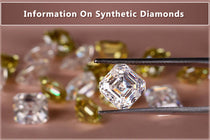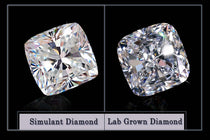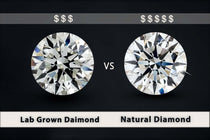Diamonds have long been admired for their beauty and value, making them a popular choice for jewelry and adornments. While natural diamonds can indeed be mesmerizing, their high prices have given rise to the demand for a more affordable alternative. Enter the world of fake diamonds – sparkling stones designed to mimic the appearance of genuine diamonds yet available at a fraction of the cost.
These imitation diamonds have come a long way in terms of quality and believability. Various materials are used to create these convincing substitutes, including cubic zirconia and moissanite.
The best fake diamonds on the market today often exhibit a striking resemblance to their natural counterparts, making it difficult for the untrained eye to differentiate between the two. As a result, fake diamonds have become increasingly popular for consumers seeking an affordable alternative to the real thing without sacrificing the shimmer and shine that diamonds are known for.
When shopping for the best fake diamond, it is essential to understand the characteristics of these synthetic stones and how they differ from natural diamonds. By educating yourself on the different types of fake diamonds and their unique features, you can make a more informed decision as you select the perfect imitation gem for your needs.
Understanding Diamonds
| Topic | Description |
|---|---|
| Composition | - Diamonds are composed of carbon atoms arranged in a crystal lattice structure. - They are one of the hardest natural substances, ranking 10 on the Mohs scale. |
| Physical Properties | - Diamonds exhibit exceptional hardness, making them resistant to scratching. - They have a high refractive index, which contributes to their brilliance. - Diamonds are excellent conductors of heat, dispersing it quickly. - They have a high density and are heavier than most other gemstones. |
| Brilliance and Fire | - Brilliance refers to the white light reflection from the diamond's facets, creating sparkle. - Fire is the dispersion of light into spectral colors, resulting in the diamond's colorful flashes. - Both brilliance and fire are influenced by the diamond's cut and quality. |
| Diamond Cuts | - Diamond cuts include various shapes such as round, princess, emerald, and more. - The cut influences how light interacts with the diamond, affecting its brilliance and fire. - Well-cut diamonds maximize light return, enhancing their beauty. |
| Carat Weight | - Carat is the unit of measurement for a diamond's weight, with 1 carat equal to 0.2 grams. - Larger diamonds generally have higher carat weights and may be more valuable, but other factors also impact a diamond's worth. |
| Diamond Pricing | - Diamond pricing is influenced by the "Four Cs": carat weight, cut, color, and clarity. - Other factors like shape, fluorescence, and certification can also affect the price. - Diamonds with excellent grades in the Four Cs tend to be more expensive. |
| Certification | - Diamonds are often certified by gemological laboratories like GIA (Gemological Institute of America) or AGS (American Gem Society). - Certification provides information about a diamond's quality and authenticity, aiding in pricing and purchase decisions. |
Composition of Diamonds
Diamonds are composed of carbon atoms arranged in a crystal lattice structure, giving them their unique properties. They form naturally over billions of years under intense heat and pressure deep within the Earth's mantle. This geological process results in the creation of beautiful and enduring natural diamonds, treasured for their sparkle and resilience.
Physical Properties of Diamonds
Diamonds are renowned for their exceptional hardness, ranking at 10 on the Mohs scale. This property makes them the perfect material for cutting tools and wear-resistant surfaces. Additionally, diamonds have a high refractive index, meaning they can bend light significantly, leading to their extraordinary brilliance and fire.
Brilliance and Fire in Diamonds
The brilliance of a diamond refers to the light reflected from its interior, while fire represents the dispersion of light into different colors. These characteristics are influenced by the stone's cut and polish, which determine how light interacts with the diamond. A well-cut diamond ensures that light enters the stone, reflects off its various facets, and exits through the top, giving the diamond its signature sparkle.
Diamond Cuts and Carat Weight
A crucial aspect of a diamond's appearance and value is its cut. Diamond cuts, such as round, princess, and cushion, influence the gem's visual appeal by enhancing its shape, symmetry, and proportions. The carat weight of a diamond is the unit used to express the mass of the gemstone, with one carat equal to 200 milligrams. However, size isn't the sole determinant of a diamond's value, as factors like clarity, color, and cut also play a significant role. To provide a better understanding of size, resources like this size and comparison guide offer valuable insights for diamond enthusiasts.
Diamond Pricing
The price of a diamond varies based on factors such as carat weight, cut, color, and clarity - commonly known as the 4Cs. Larger, high-quality diamonds with excellent color and clarity are generally more expensive than smaller or lower-quality stones. Although carat weight can be influential, the true essence and dimensions of a carat in gemstone parlance go beyond just weight. In addition, demand for specific diamond shapes can also affect pricing. It is crucial to remember that each diamond is unique, and understanding these factors will help buyers make informed decisions when purchasing diamond rings or other diamond jewelry.
Fake Diamonds Overview

Types of Fake Diamonds
There are several types of fake diamonds, ranging from imitation to synthetic stones. Imitation diamonds are made of materials that only resemble diamonds in appearance but don't have the same chemical properties. Examples include cubic zirconia, moissanite, zircon, white sapphire, spinel, topaz, synthetic garnet, rutile, corundum, and quartz.
On the other hand, synthetic diamonds have similar chemical properties to natural diamonds but differ in their origin, as they are artificially created. Some popular synthetic diamonds include cubic zirconia and moissanite.

How Are Fake Diamonds Made
The manufacturing process of fake diamonds varies depending on the type of stone. For example, cubic zirconia and synthetic diamonds are usually created through high-pressure, high-temperature conditions, which aim to replicate the natural process of diamond formation. Moissanite, another synthetic diamond, is produced through a process called chemical vapor deposition.
On the other hand, materials like white sapphire are typically created using heat treatment or irradiation to enhance their color and appearance. Synthetic materials like corundum and spinel can also be produced using various methods such as the flame fusion or melt processes.

Spotting the Difference
Identifying fake diamonds can be a challenging task without proper knowledge or tools. However, there are some key indicators that can help to distinguish between genuine and fake stones. One is the hardness of the stone. Natural diamonds are known for their exceptional hardness and resistance to scratches, while many imitation diamonds can be scratched more easily.
Another important aspect to consider is the appearance of the stone. Many fake diamonds, such as cubic zirconia and moissanite, are more likely to display intense, colorful fire than natural diamonds, which can be an indicator of their artificial nature. Moreover, natural diamonds typically have tiny imperfections known as inclusions, while many fake diamonds may appear flawless or have a different pattern of inclusions.
A common test to detect fake diamonds is the fog test, which involves breathing on the stone and observing how long it takes for the fog to dissipate. Since natural diamonds effectively disperse heat, the fog will disappear quickly, whereas the fog may linger on a fake stone. However, be advised that some synthetic diamonds like moissanite can also pass this test, making it necessary to employ a combination of methods when evaluating a stone's authenticity.
Comparing Real Diamond and Fake Diamond
| Aspect | Real Diamond | Fake Diamond |
|---|---|---|
| Composition | Composed of carbon atoms arranged in a crystal lattice structure. | Usually made of materials like cubic zirconia or moissanite. |
| Hardness | One of the hardest natural substances, ranking 10 on the Mohs scale. | Softer than real diamonds and can be scratched more easily. |
| Brilliance | Exhibits exceptional brilliance due to its high refractive index. | May lack the same level of brilliance and sparkle as real diamonds. |
| Price | Real diamonds are typically more expensive due to their rarity and quality. | Fake diamonds are more affordable and accessible. |
| Origin | Mined from the earth and can be natural or lab-grown. | Synthetic or lab-created diamonds are intentionally manufactured. |
| Use in Jewelry | Commonly used in high-end jewelry pieces. | Often used in costume jewelry and as diamond simulants. |
Price Comparison
When looking at the difference between real diamonds and fake diamonds, one of the most apparent distinctions is their price. Real diamonds are usually more expensive due to their rarity and natural formation. In contrast, fake diamonds such as cubic zirconia, moissanite, and white sapphire are more affordable options. These alternatives can be nearly as beautiful as their natural counterparts, making them attractive to budget-conscious shoppers.
Appearance Comparison
There are some subtle differences in appearance between real diamonds and their synthetic alternatives. Diamonds are known for their brilliance, sparkle, and colorless appearance. Fake diamonds can come close in these aspects, but they might not be as perfect. For example, cubic zirconia can appear more cloudy or less clear in comparison to a genuine diamond. Additionally, moissanite has a slightly different refractive index, causing a distinctive "fire" effect that can be visually distinguished from a diamond. Lastly, white sapphires have a less brilliant sparkle and may not capture light as effectively as a real diamond.
Durability Comparison
Diamonds are known for their exceptional hardness, making them resistant to scratches and everyday wear. Synthetic alternatives like moissanite and cubic zirconia also have high hardness ratings, although they might be slightly more susceptible to scratches than a diamond. On the other hand, white sapphires have a lower hardness rating, making them more prone to damage over time. If durability is a primary concern, real diamonds still hold the advantage.
Choosing for Engagement Rings
For engagement rings, many people still prefer the traditional choice of a real diamond. However, fake diamond alternatives like moissanite are growing in popularity due to their more affordable price and nearly identical appearance. The decision between a natural diamond, a lab-grown diamond, or a fake diamond engagement ring is ultimately up to the couple's preferences, budget, and values.
When selecting a gemstone for an engagement ring, keep in mind the price, appearance, and durability differences between real diamonds and their synthetic counterparts. Don't be afraid to explore various designs to find the perfect ring that reflects both style and personal values.
Best Fake Diamond Brands and Tips for Buying

Fake diamond alternatives, such as cubic zirconia, moissanite, simulated diamonds, synthetic diamonds, and white sapphire, are popular choices for those who desire the look of genuine diamonds without the hefty price tag. When choosing the best fake diamond for engagement rings or other fine jewelry, consider the characteristics and qualities of each alternative.
- Cubic zirconia, a popular choice for engagement rings, is an affordable and durable option that closely resembles a real diamond. It is available in a variety of shapes and sizes, making it a versatile choice for various jewelry pieces. Moissanite, another excellent diamond alternative, is known for its exceptional brilliance and fire, making it a top choice for those seeking a stunning, eye-catching gem.
- Synthetic diamonds, also called lab-grown diamonds, are not exactly fake, but they are man-made. They have the beauty and physical properties of natural diamonds but at a lower cost. Synthetic diamonds are crafted by replicating the conditions under which diamonds naturally form, resulting in a gem that rivals the real thing.
- When searching for the best fake diamond jewelry, consider browsing unique and lesser-known platforms like Etsy to find handcrafted and personalized pieces. This online marketplace features a wide variety of talented designers and artisans who provide quality alternatives to traditional diamond jewelry.
- While shopping for fake diamond jewelry, examine the stone's cut, clarity, and carat. A stone with a precise cut will reflect light beautifully and enhance its sparkle, while the clarity refers to any inclusions or imperfections that can impact the stone's appeal. The carat weight will determine the size of the stone, so choose a suitable size based on personal preference and the jewelry's design.
- Lastly, pay attention to the metal selection for fake diamond jewelry. Opting for a higher-quality metal, such as gold or platinum, can elevate the overall appearance of the piece and ensure its durability and longevity. By considering these factors, you can confidently select the perfect fake diamond jewelry that meets your style and budget requirements.
Frequently Asked Questions
What are the best types of fake diamonds?
There are several types of fake diamonds in the market, but the most popular and convincing ones are cubic zirconia and moissanite. Both gemstones have unique characteristics that make them suitable substitutes for a real diamond, offering a similar shine and sparkle.
How can I find realistic fake diamond rings?
To find realistic fake diamond rings, look for designs that resemble real diamonds in terms of cut, clarity, color, and carat size. High-quality cubic zirconia or moissanite stones are excellent options because they offer stunning sparkle and are more affordable than real diamonds.
Which is better: cubic zirconia or moissanite?
Both cubic zirconia and moissanite are popular choices for fake diamond rings, but they have different properties. Moissanite is known for its remarkable brilliance and fire, making it a closer match to real diamonds. Cubic zirconia is less brilliant but still provides an impressive sparkle at a lower cost. If you prefer a gemstone that closely mimics a diamond, then moissanite might be the better choice.
What are the key differences between fake and real diamonds?
Fake diamonds, such as cubic zirconia and moissanite, share some similarities with real diamonds. However, there are key differences in their physical and chemical properties. Real diamonds are the hardest natural substance, while fake diamonds are slightly softer. Additionally, real diamonds typically have inclusions, while fake diamonds usually have fewer imperfections. Another key difference is the way they react to light, with real diamonds showing more dispersion and scintillation than fake diamonds.
Where can I buy high-quality fake diamond necklaces?
You can buy high-quality fake diamond necklaces at various online retailers or local jewelry stores. When searching, look for well-crafted designs featuring high-quality cubic zirconia or moissanite stones to ensure the necklace appears realistic and elegant.
How to choose a convincing fake diamond engagement ring?
To choose a convincing fake diamond engagement ring, opt for a design that features a high-quality cubic zirconia or moissanite stone. These stones offer a similar appearance to real diamonds and are more affordable. Consider factors such as the cut, clarity, color, and carat size of the fake diamond, as well as the ring's setting and metal. Additionally, you may want to browse through various bridal sets to find the perfect match for your taste and budget.
Checkout some of our top collections:









